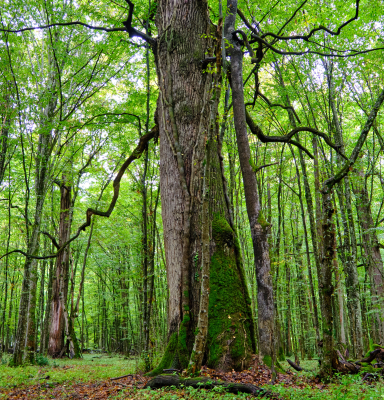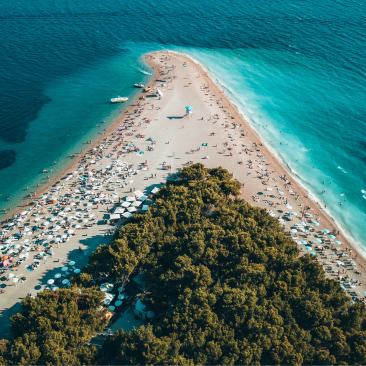

Forest area
Forests and other forest land make nearly a third (32%) of total area of the Republic of Croatia (including the sea surface) and cover an area of 2 759 039 hectares.

Considering only land surface, forests and other forest land cover nearly half (49%) of terrestrial Croatia. Croatia may be considered an above-average forested country, considering the relative forest cover in Europe stands at 35%.

Forest use
According to the Law on Forests (Zakon o šumama), forests are classified according to their purpose into productive, protective and special purpose forests, which roughly defines the primary goal of forest management.
By classifying an individual forest into one of the legally defined categories of purpose, a particular function of the forest is highlighted, which is more pronounced, whereby the chosen management method and goals for each specified category must meet the strategic determinants of sustainable management.


Productive forests are used for the production of forest products while preserving and improving their general useful functions.
There are 1 425 809,46 ha of productive forests in Croatia.

Protective forests primarily serve to protect land, water, settlements, facilities and other property. Protective forests include forests in sensitive habitats, forests with high biological diversity, forests on public water resources, rare or representative forest communities, and forests to protect soil, roads and other structures from erosion and flooding.
Forests that thrive in habitats with a large proportion of stones with the appearance of smaller or larger stone blocks, which is characteristic of mountainous areas, and forests in lowland areas in humid depressions where water stagnates for most of the year and makes management and restoration impossible can also be considered protective forests.
There are 832 095,82 ha of protective forests in Croatia.

Special purpose forests include forest seed facilities, forests within protected areas or natural values protected on the basis of regulations on nature protection, forests intended for scientific research, teaching, the needs of the defence of the Republic of Croatia, the construction of golf courses and camps, and the needs determined by a special regulation.
Forests within the protected areas are divided into: 2 strict reserves, 8 national parks, 79 special reserves, 12 nature parks, 2 regional parks, 79 natural monuments, 81 significant landscapes, 27 park-forests.
There are 501 133,77 ha of special purpose forests in Croatia.
Cultivation form
The forest stands are classified by cultivation form into stands of high cultivation form (high forests), low cultivation form (coppice forests), degraded stands (scrubland, thickets, maquis, garrigues), forest plantations and forest cultures.


A high forest is a type of forest originated from seed or from planted seedlings. In contrast to a low forest (also known as a coppice forest), a high forest usually consists of large, tall mature trees with a closed canopy. High forests can occur naturally or they can be created and maintained by human management. Trees in a high forest can be of one, a few or many species. A high forest can be even-aged or uneven-aged.
High forests have relatively high genetic diversity compared with coppice forests.
There are 1 393 816,87 ha of this forest cultivation form in Croatia.

Coppice forest is a low growing form of forest. In these forests most of the trees were created by growth from cut stumps. The most common species used are: acacia, common and black hornbeam oak, beech, honey oak, holm oak, cera oak, black alder and chestnut.
Coppice forests are created intentionally, because of the need for firewood or because of the needs of hunting (they correspond to certain types of game). Some coppice forests can be caused by poor forest management. Stumps have a lower quality of growth of wood mass and and usually generate less ecosystem services compared to high forests. Therefore, it is advisable to gradually turn the stumps into high forests, so that they are of better quality.
There are 358 802,98 ha of this forest cultivation form in Croatia.

Degraded stands include scrubland, thickets, maquis and garrigues.
Scrubland - a degraded coppice forest where trees and bushes participate in the same floor or layer.
Thicket - a degraded form of scrubland, i.e. an area overgrown with bushes, mostly bushy in shape.
Maquis - the degradation stage of a holm oak forest formed from a stump.
Garig - degraded maquis of bushy evergreen species with an assemblage that covers about 50% of its surface, and the rest is a smaller clearing.
There are 665 794,35 ha of this forest cultivation form in Croatia.
Wood stock

The wood stock of the Republic of Croatia equals to 418 618 277 m3, of which 334 914 019 m3 in forests owned by the Republic of Croatia and 83 704 258 m3 in private forest owners' forests. Forests owned by the Republic of Croatia account for 80% of the total wood stock, and forests owned by private forest owners account for 20%.
Compared to 2006, the wood stock of the forest management area increased by 20.6 million m3, i.e. by 5%, as measured in 2016.
Fagus sylvatica, or European beech, is one of the most important and widespread broadleaved trees in Europe. It is a large deciduous tree that can maintain its high growth rate until late maturity. Its natural range extends from southern Scandinavia to Sicily, from Spain in the west to northwest Turkey in the east. Its wood is strong and wears well making it ideal for a wide range of uses, from furniture to musical instruments, as well as for pulp and firewood.
Quercus robur, or common oak, is a large tree, native to most of Europe and western Asia, and is widely cultivated in other temperate regions. Common oak is a deciduous tree up to 40 m tall, with a single stout trunk that can be as much as 11 m in girth. The species most likely to be confused with it is sessile oak, also often found species in Croatia, which shares much of its range. Common oak is distinguished from sessile oak by its leaves having auricles at the base, the very short petiole, its clusters of acorns being borne on a long peduncle, and the lack of stellate hairs on the underside of the leaf. It is planted for forestry, and produces a long-lasting and durable heartwood, much in demand for interior and furniture work.
Increment and allowed harvest
The current annual increase at the level of the forest management area is 10 146 149 m3, of which 7,932,404 m3 is in the forests owned by the Republic of Croatia, and 2,213,745 m3 in the forests of the private forest owners.
The wood stock harvest plan is prepared in accordance with the provisions of the Law on Forests and the Ordinance on Forest Management and the principles of sustainable forest management. The harvest plan for the next ten-year period is planned for the area of 1,288,821 ha in the amount of 80 371 722 m3(64 721 765 m3 in state-owned forests and 15 649 957 m3 in private forests). In other words, the current allowed annual harvest quantity is about 8 037 172,2 m3.

In the planned area for harvest, the most represented type of tree is common beech (36%), followed by sessile oak (11%), common hornbeam (10%), common oak (9%), common fir (7%), field ash (4%), while other types of trees are represented by 23%.
Annually, less than the total increment is harvested in the forests, which ensures the future of sustainable forest management and healthier forests.
Forest ownership
Of the total area of forests and forest land, 2 097 318,16 hectares or 76% are owned by the Republic of Croatia, and 661 720,89 hectares or 24% are owned by private forest owners. There is over 600 000 private forest owners in Croatia and most forests are smaller than 1 hectare.

Forest management
The goal of the management of forests and forest land in the Republic of Croatia is sustainable multi-purpose forest management.
According to the Forestry Strategy of the European Union, the guiding principles and goals are:
- Sustainable forest management and the multifunctional role of forests, whereby numerous forest services are provided in a balanced way and forest protection is ensured;
- Efficient use of resources, whereby the contribution of forests to rural development and job creation is optimised;
- Promotion and sustainable production and consumption of forest products.
In the Republic of Croatia, three methods of managing forest stands are prescribed:
- even-aged (regular)
- selective
- uneven-aged.
The above mentioned types of management differ mainly with regard to the spatial and temporal implementation of silvicultural procedures of care and restoration, the horizontal and vertical distribution of trees and the ecological constitution of tree species, and they must fulfil the set goals of management, taking into account the ecological, economic and social role of forests.

In even-aged tree stands, the main species of trees in the stand are of the same age, and the management is stand-based. Even-aged (regular) management includes spatially and temporally separated implementation of silvicultural procedures of care and rejuvenation in a even-aged stand during rotation. This means that silvicultural procedures are related to the developmental stages that an even-aged stand goes through during rotation.
The rotation is the period of time from the formation of the stand to its rejuvenation.
In accordance with the principles of sustainable and multi-purpose forest management, the maturity of a stand for achieving one management goal cannot exclude the realisation of other important roles of forests (potential for natural renewal, stability, ecological role of forests). In general, when determining the length of the rotation, the starting point is absolute maturity as the lower limit and value or economic maturity as the upper limit, whereby the requirements for renewal (forestry maturity) and other management goals must not be excluded.
According to the age and stage of development, single-age stands are classified, in accordance with the Ordinance on forest management, into:
- young stands,
- medium-aged stands,
- older stands and
- old stands.
Depending on the species of trees and their development characteristics, the number of trees per unit area decreases with increasing age. At the same time, the wood stock of the stand grows and accumulates on selected trees of the highest quality, which are the bearers of growth and stability of the stand.
A normal regular forest consists of a number of even-age stands in which stands of all ages are equally represented on the surface, from the first stages of development to old stands at the age of rotation.
Even-aged stands with a high growth form are rejuvenated naturally, by so-called "rejuvenation" felling. Rejuvenation takes place under the cover of the crowning of old trees, and the trees of the old stand are gradually removed by "rejuvenation" felling, with the simultaneous appearance of a new generation of plants, i.e. a new stand. Thus, at one moment, during the rejuvenation period, two generations of forest stands grow simultaneously on the rejuvenated surface: an old stand and a new stand in the development stages.
Rejuvenation under the cover of crowning of old trees, by the means of "rejuvenation" felling includes the implementation of three basic cuts:
- preparatory cut,
- rejuvenation cut and
- final cut.
The time required for the rejuvenation of an individual stand is called the rejuvenation period and is seen as the period from the first to the last cut as part of rejuvenation felling.
Preparatory cut is the first intervention related to silvicultural procedures of rejuvenation (renewal) and not related to the care of stands. Preparatory cut enables greater access of light and heat to the crowns of those trees whose seed crop is expected on the rejuvenation surface, which accelerates their crop and enables better fruiting.
Subsequent cut is done in those stands whose tree species are sensitive to frost and soil drying, so their young trees should be gradually adapted to the new conditions.
The final cut is carried out when at least 70 percent of the surface of the rejuvenation area is covered with young shoots that are capable of independent development. Final felling removes the remaining old trees from the rejuvenation area, except for those that need to remain in order to comply with the provisions of nature protection conditions. The final cut is performed carefully, with strict control of the movement of the machinery during extraction, exclusively in winter to prevent or at least reduce damage to the young plants.
Selective cut is felling in a selective stand, and its characteristic is that mature trees and thinnings are felled on the same area, as well as care and cleaning in the young generation of the stand.
Selective stands are stands of fir with other types of trees where we find distributed trees of different heights and chest diameters, and the management is tree-wise (each tree is a unit by itself) or group-wise (on some surface we have several smaller units, the size of 1-2 the height of the trees, which are managed separately). A selective stand is a stand in which, per unit area, there are fir trees and other natural tree species in that community, which are of different heights and thicknesses, arranged in a horizontal tree-like or clustered structure and in three layers of a vertical structure.
Selective stands are made up of trees of different ages, that is, selective management is such a way of dealing with the forest that achieves that trees of all ages grow in the forest, side by side. Selective forest is composed of a number of selective stands.
Selective stands in Croatia are related to the area of fir and are spread mainly in the area of the Dinarides, i.e. the area of Gorski Kotar and Lika, in the altitude zone, usually between 600 and 1300 m above sea level.
The selective stand has a permanently non-uniform appearance and the selective form of the assembly, while the canopies are arranged at different heights, so they completely fill the entire profile of the stand down to the ground, and the ground is repeatedly covered by canopies.
With regard to the vertical classification, the profile of the selected stands differ
- dominant,
- intermediate and
- suppressed trees.
In a superior position are those trees whose crowns develop freely or are slightly influenced by the crowns of neighboring trees and which have fought for space in the ground and above the ground. In an intermediate position are trees that compete with neighboring trees and fight for living space in the middle and upper layers, and in the case of favourable structural changes (felling), they fight for a dominant position in the stand. The trees in the understory layer are suppressed trees that are heavily shaded from above, with a small height increase and are also waiting to grow into the upper positions in the stand in a certain time and structural conditions.
Unlike single-age stands, where the stands are classified by age classes, age is not indicated in selective stands, so the structure of the wood stock is classified into three thickness classes (10-30 cm; 31-50 cm; and from 51 cm upwards).
The wood stock in a normal selection stand has slight oscillations over time and this amount should range from a minimum value at the beginning of the "patrol" to a maximum value at the end of the "patrol", therefore the structure of a normal selection stand should be constant over time. A patrol is the time that elapses between two regular felling operations in the same stand.
In an approximately normal selection forest, the amount of wood stock intended for felling is approximately equal to growth, i.e. in a normal selection forest we cut the growth that accumulates in one area of the stand on which felling is carried out in the same year. By selecting a tree for felling and felling in a selection stand, care and rejuvenation are carried out at the same time, a selection structure is formed, the forest is exploited and its hygiene is maintained.
In contrast to even-aged stands, in which the management goals are met with a given rotation (the time period from the formation of the stand to its rejuvenation), the management goals in selective stands are met by achieving the diameter of the cutting maturity of the main tree species, which are determined on the basis of the purpose of the forest, credit rating and goal management. According to the research on the diameter of the harvest maturity of the fir trees, the most favourable diameters of the harvest maturity of the fir trees were determined from 60 to 70 cm.
In normal uneven-aged stands, groups of trees of different ages and developmental stages are distributed, where the trees within each group are of the same age and developmental stage, and the management is group-based. The area of a single group of trees of the same age and development stage in uneven-aged stands should be from 0.2 ha to 2.0 ha. Groups of trees should be arranged in a mosaic and spatially separated within a single uneven-aged stand.
Due to its structure (smaller rejuvenation area, slight oscillations of the wood stock over time), the choice of uneven-aged management is applied in karst forests, private forest owners' forests, special purpose forests, protective forests and in forests that have an important protective function.
The normal wood stock of uneven-aged stands of high growth form is equal to half of the normal wood stock of a mature even-aged stand.
With regard to the goals of management in uneven-aged stands, the cutting maturity of each group is determined on the basis of the prescribed rotation of the main tree species, taking into account the purpose of the forest and the cultivation form.
In uneven-aged stands, age is not shown, so the structure of wood stock is shown in three thickness classes (10-30 cm; 31-50 cm and from 51 cm upwards). Likewise, the wood stock in a normal uneven-aged stand has slight oscillations over time, and this amount should range between the value at the beginning of the rotation (before felling) and the value at the end of the rotation (after felling). A rotation is the time that elapses between two regular felling operations in the same stand.
Group management on smaller areas is provided for in a uneven-aged way, where each group represents a separate part of the stand with specific silvicultural procedures. In this way, uneven-aged management has the features of regular (even-aged) management, but on smaller areas where all silvicultural procedures carried out are determined by the development stage of a certain group of trees within the stand.
Based on this, uneven-aged management has the characteristics of regular management, since cultivation operations of care and restoration are planned and carried out in the same way as in even-aged stands, only in spatially separated groups of 0.2 ha to 2.0 ha.
Uneven-aged management was made possible for the first time by the provisions of the Ordinance on forest management from 2006, but the current state of most stands that should be managed in a uneven-aged way, usually deviates from the theoretical assumptions of the normal structure of uneven-aged stands.
Additional resources

Forest management plan
To read more about the current state and future forest management in Croatia, please access the original forest management plan for the period of 2016-2025.

Croatian forests on a map
If you would like to learn more about the forests in Croatia and see how forests look like in different zones on the interactive map, access the public portal below.
